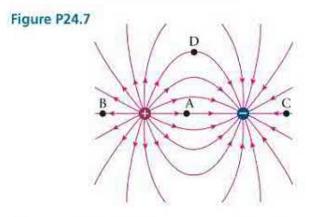Figure (mathrm{P} 24. 7) shows the electric field produced by an electric dipole. How would a positively
Question:
Figure \(\mathrm{P} 24. 7\) shows the electric field produced by an electric dipole. How would a positively charged test particle begin to move when released from rest \((a)\) at point \(A\), (b) at point \(\mathrm{B},(c)\) at point \(\mathrm{C}\), and \((d)\) at point D? Assume that no other objects exert forces on the test particle. (e) How does your answer to part \(a\) change if the test particle has an initial velocity that makes some angle \(\theta eq 0\) with the electric field at \(A\) ?
Data from Figure 24.7

Fantastic news! We've Found the answer you've been seeking!
Step by Step Answer:
Related Book For 

Question Posted:





